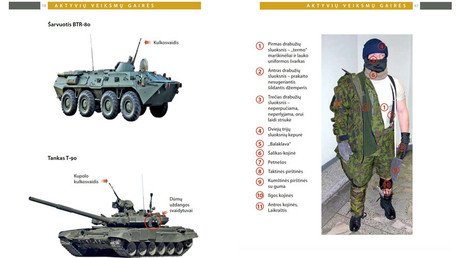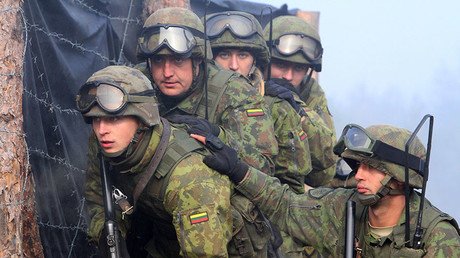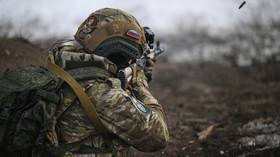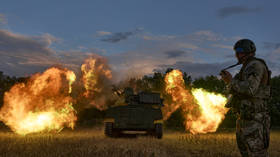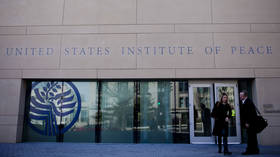Lithuanian town raided by rebels in surprise ‘Russian invasion’ drill
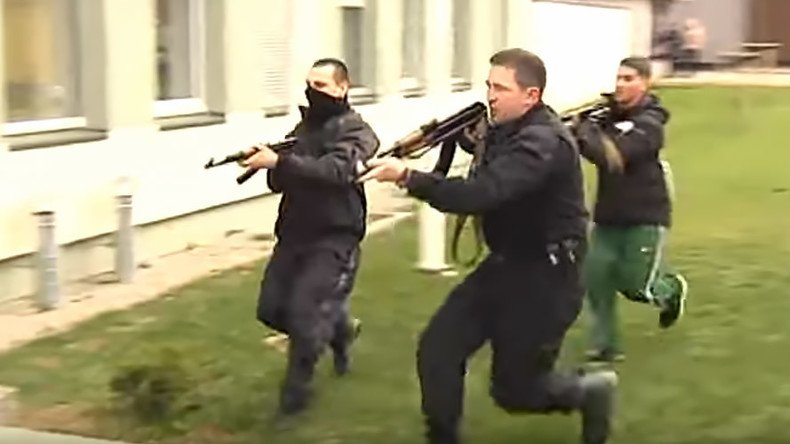
A group of gunmen invaded a border town in Lithuania and seized its police HQ, while officers failed to mount a proper response and residents did not bother to report the ongoing raid. Luckily, the militants were from a fictitious nation and part of a surprise drill.
The chaotic and somewhat embarrassing exercise was conducted on Tuesday in the Salcininkai region in south-eastern Lithuania. Ordered by Interior Minister Eimutis Misiunas, only senior leaders of the regional emergency services and border guard unit were informed beforehand.
The drill involved some 30 men from the nation of ‘Udijos’ crossing the border, taking over the guard outpost, and advancing through the woods to the Salcininkai town to storm its police commissariat.
“We wanted to test in real conditions how the Lithuanian emergency service would respond to such an emergency,” Misiunas told the media as cited by the Delfi news. “It was an imitation of an invasion by ‘little green men’ in Lithuania.”
The term refers to Russian Special Operations troops, which were involved in the events in Crimea in 2014 following an armed coup in Ukraine. Masked uniformed men without insignia were deployed from the Russian naval base in Sevastopol across the peninsula to secure key sites like power stations and block Ukrainian military bases.
The deployment was justified by Moscow citing the impending arrival of Ukrainian right-wing extremists to the predominantly Russian region, and the need to prevent bloodshed in case Kiev ordered its troops to suppress locals. Crimean regional authorities used the protection of the Russian special forces as well as local volunteers to organize a referendum and formally sever ties with the post-coup authorities in Kiev to rejoin Russia.
However, Baltic states like Lithuania claim that Russian troops in Crimea were an occupational force and believe that Moscow may “invade” them next. The Salcininkai exercise was apparently meant to test local authorities' preparedness for such a contingency, though the ‘Udijos’ gunmen acted more like a militant gang or a rebel force, according to media accounts.
They successfully overpowered officers at the commissariat and took several hostages, including a journalist. The local police tried hastily to organize an attempt to take their HQ back only to be met with machine gun ‘fire’ and were 'killed or captured.' The hostage-takers demanded the release of their ‘fellow fighters’ from Lithuanian prisons.
Salcininkai officials requested help from the national government, but the report was sent too late. By the time the ARAS anti-terrorism team arrived from the capital Vilnius, the deadline of the hostage-takers expired, and they started 'killing the hostages.' A siege that ARAS were preparing to start was eventually aborted as the Interior Ministry stopped the drill.
Misiunas told journalists the surprise exercise was meant to reveal the lapses in planning and preparation of the region’s services, and in that regard it was a success. He noticed a failure of the local police to organize their response, and to evaluate the threat posed by the militants, while promptly requesting help.
Itin nemaloniai nustebino vietos gyventojų reakcija – nei vienas gyventojas pagalbos telefonu nepranešė apie... https://t.co/HPwRysIFcv
— DELFI Lietuva (@DELFILietuva) 12 апреля 2017 г.
He also said the Lithuanian government was somewhat surprised by the apathy of local residents, who failed to alert the authorities of the movements of the gunmen. They complained instead that the exercise messed up their routines according to the local emergency information center.
“Some were angry that they cannot get to where they need. Others were curious about what was happening," the center's spokeswoman Vilma Juozeviciute said.
The interior minister said Lithuanians should act more responsibly in such emergencies.
“This was not a demonstration drill with blanks shot and smoke. Enemy forces would act stealthily, so the important part was to notice them in time, report their movement and respond accordingly,” he said.
The Salcininkai region is located on Lithuania’s border with Belarus. Many of the people living there belong to the Polish ethnic minority, comprising over 70 percent of the region’s population.
The Lithuanian government earlier took other questionable measures to prepare for potential confrontation with Russia, including publishing a controversial manual for its citizens of what they should do under a Russian occupation.
Lithuania's State Security Department also created an ad campaign warning of the potential risk of falling victim to “hostile foreign intelligence” during normal conversations with friendly strangers.
READ MORE: Stranger danger: Lithuanian ad campaign warns of friendly spies (VIDEOS)
While Moscow has always denied having any aggressive plans towards the NATO nation, Lithuanian intelligence agencies recently produced yet another security report claiming that Russia threatens the country in numerous ways, from a possible military incursion to promoting a positive image of itself. The Kremlin called the report an example of “hysterical Russophobia.”
